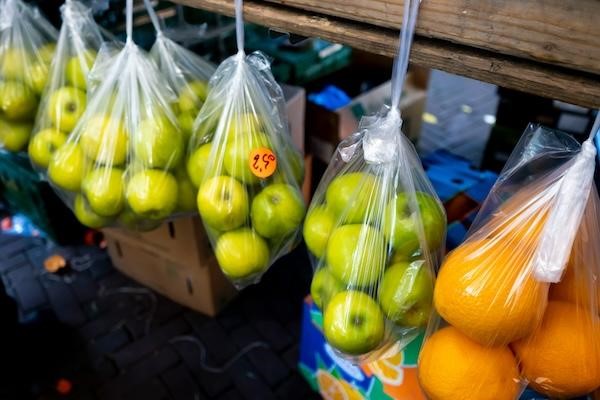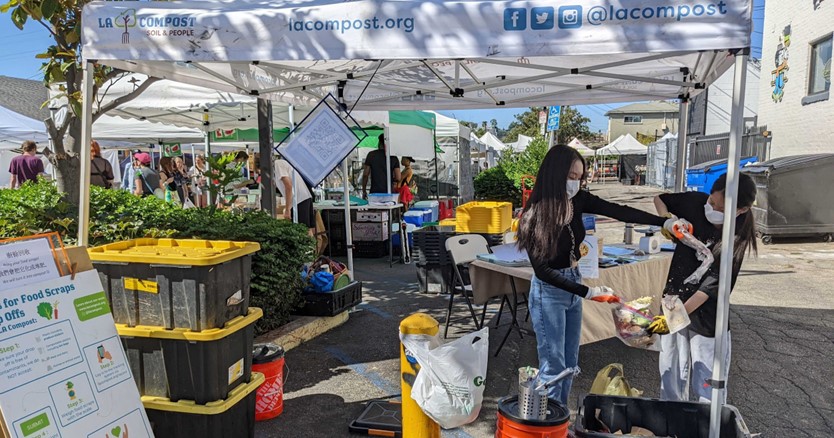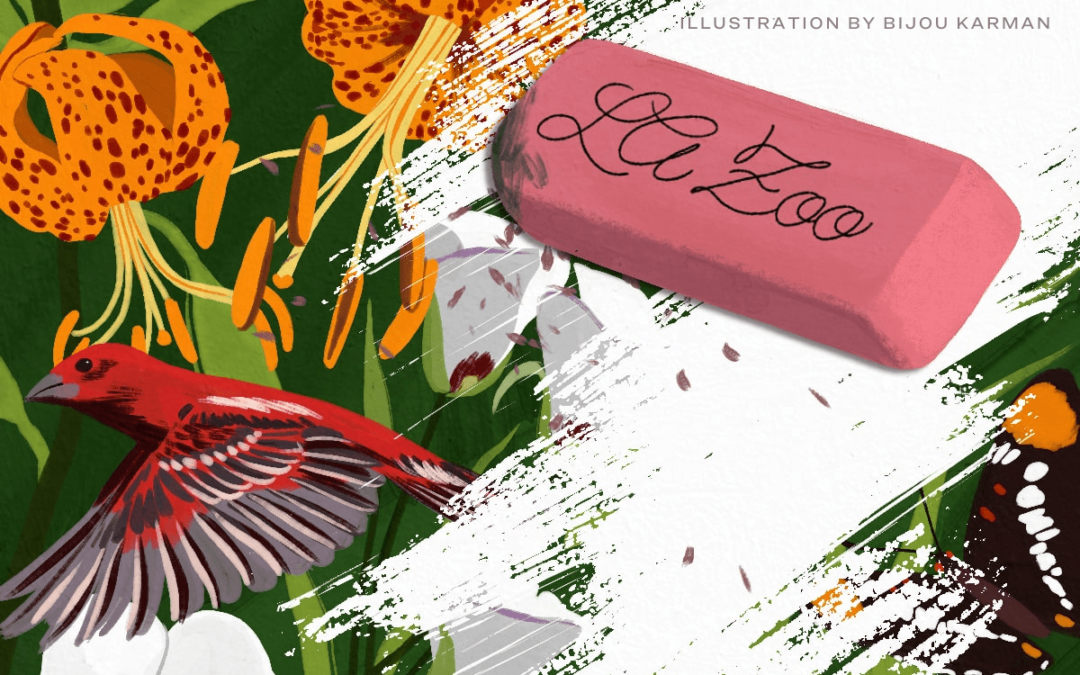
by SCLA | Mar 29, 2024 | Explainers
By Sarah Lawton
Every time you finish unpacking groceries in Los Angeles, do you give your recycling bin a little pat on the lid? It’s a routine for many Californians – toss the plastic produce bags in, flatten the to-go container, and feel good about doing your bit for the environment.
But hold on a minute – are you sure everything you’re tossing in there is actually recyclable? Turns out, navigating LA’s recycling rules can be trickier than assembling furniture from IKEA. And to make matters worse, LA Sanitation keeps changing the rules, leaving us scratching our heads about what goes where.
Lately, they’ve tightened things up even more. Now, only plastics labeled with codes 1, 2, and 5 get the green light for recycling. All other plastics? Straight to the trash. It’s enough to make your head spin. So, here’s a quick guide from LA Sanitation & Environment (LASAN), and a summary of what the codes mean:
- Code 1 (PET Plastics): Think soda bottles and peanut butter jars.
- Code 2 (HDPE Plastics): Milk jugs and shampoo bottles are a go.
- Code 5 (Polypropylene Plastics): Deli soup containers and yogurt tubs – recycle away!
Clean paper, metal cans, and glass bottles are all fair game for the recycling bin too. But that greasy pizza box? That’s where the compost bin comes in. Since 2023, it’s been mandatory for all of us Angelenos to have one. Don’t comply? Prepare for a fine.
Coffee grounds, eggshells, and even those napkins with a bit of sauce on them – all perfect for composting. But here’s the kicker: those “compostable” utensils? Not so much. Despite the label, they go in the trash because they need special conditions to break down properly. And those flimsy plastic bags from the grocery store? Toss ‘em in the trash. They don’t have the necessary properties for easy recycling either.
As we tackle the ins and outs of waste management, let’s keep striving for greener solutions.
Need a quick guide to help you sort it all out? Check out this guide from LA Sanitation & Environment (LASAN).
Now go ahead, give your recycling bin a hug – just make sure it’s filled with the right stuff.

by SCLA | Mar 29, 2024 | Explainers
Guest article by Elena Lopez, Outreach and Communications Manager for LA Compost
LA Compost was born in 2013 from the passion and collaboration of volunteers, friends, and families, driven by a shared desire to raise awareness about the environmental impact of organic waste. Initially, our dedicated collection crew pedaled through the streets with bike trailers, ferrying food scraps, leaves, paper, and other organic materials from various establishments to local compost centers. While successful in other cities, this approach proved challenging to sustain in the vast expanse of Los Angeles.
In 2014, LA Compost pivoted towards a decentralized model centered on community compost hubs, nurtured and cherished by engaged local residents. These hubs sprouted in churches, schools, gardens, and workplaces, weaving into the fabric of neighborhoods across LA County. Each hub is a unique reflection of its community, yet all share the common goal of composting locally while fostering connections among people and nature.
In 2018, we aligned our initiatives with the Hierarchy to Reduce Food Waste and Grow Community, as outlined by the Institute for Local Self-Reliance. Our programs cater to individuals through home composting, and empower communities with education and access to a decentralized composting network, including our Farmers’ Market Food-Scrap Drop-off program.
Reflecting on a decade of composting efforts alongside communities throughout Los Angeles in 2023, we draw inspiration from the boundless creativity of each engaged community. What began modestly as bike-powered collections and backyard composting among friends and family has evolved into a robust network of drop-off locations, processing hubs in parks, and educational initiatives citywide.
The rollout of the City of Los Angeles’ Organics LA program in 2023 marked a significant milestone, enabling 750,000 single-family homes to participate in curbside organics collection, in compliance with the statewide mandate SB 1383. We eagerly collaborate with the city to surpass these requirements.
Looking ahead, our vision encompasses expanding Farmers’ Market Food-Scrap Drop-off locations, fortifying existing Compost Hubs, launching new Park Hubs for localized processing, enhancing Compost Coaching opportunities, and introducing the “Magic Soil Bus” to educate K-12 students about composting.
As we celebrate a decade of progress, we acknowledge that our achievements are fueled by the collective efforts of partners and supporters—our “human network.” Just as mycelium nourishes the soil, our community members nurture thriving ecosystems across LA. As advocates for the Sierra Club, we trust in your commitment to preserving vibrant communities and ecosystems for all beings. You can get involved by finding a composting option near yousigning up to volunteer, or making a donation to support our mission.
Thank you, and we look forward to welcoming you to a compost pile soon.

by SCLA | Mar 29, 2024 | Explainers
By Joan Schipper
Buying fresh, locally sourced produce in just the amount you need reduces food and packaging waste. Your nearby Certified Farmers Market (CFM) is a great place to start. From the Los Angeles County Certified Farmers Markets website:
About Farmers Markets. The term “certified” used in the phrase “Certified Farmers’ Markets” means that the produce is brought to the market straight from the farm, either by the farmer personally, a family member, or by an employee. Only California grown produce may be certified.
Not all outdoor markets are CFMs. Some are for-profit ventures, organized to bring produce from the wholesale produce market downtown. Many of the same CFM advantages will apply, but the goods will not come straight from the farm.
Shopping a CFM means that, without the middleman, more of your grocery dollars go into the farmers’ pockets. To be sure, you will find less variety without imported goods (like Chilean peaches in December). But your seasonal fruits and vegetables will be fresher and unlikely to be treated for preservation or cosmetics.
At a CFM, you can choose just as much as you want from organic and sustainable produce offerings, and pack it in your own reusable bags. You might also find local bread, eggs, meats, flowers, and plants. One of my favorite farmers brings olive oil, olives, and vinegars. For shopping-day convenience, most markets host a variety of ready-to-eat foods or prepared ingredients.
An unexpected benefit of shopping at the smaller neighborhood farmers market is the social aspect. You’ll meet neighbors, as well as farmers’ representatives, and maybe trade produce-selection advice, menu ideas, recipes, and cooking techniques. Many markets feature a roster of local musicians; bring your pals and stop for coffee and a croissant, or a tamale, after shopping.
So, how do you get started shopping locally? The best way to get started is to check the LA County Certified Farmers Markets Website, where you can search by location or browse by community name.
It may take some time to find your favorite market and, if you are lucky, there will be a number of them within your personal “shopping zone.” Explore a few and figure out whether you like a small, nearby market or a large, varied market. Are you interested in the prepared food and other merchandise offered at large markets? Are the community programs (health expos, pie- or pickle-making contests, agency fairs) engaging? Do the kids love a petting zoo with alpacas, ducks, pot-belly pigs and bunnies?
When you arrive at a market, explore a little before you start buying. The vendors’ offerings will change from week to week as the seasons progress. Browse first to see who has the cucumbers, tomatoes, lettuce, or squash you prefer. You might find some deals like “soft” tomatoes or “ugly” pears.
Consider bringing paper, mesh, or used plastic bags for each kind of produce, and remember to bring your carry-all, tote, basket, or market cart to manage your purchases. You’ll be amazed at the variety of carts and wagons shoppers employ to haul their goods up and down the market. Happy and sustainable shopping!
_______________
Joan Schipper retired early on the Hiking-is-My-Retirement-Plan. On weekends, she leads hikes with the Central Group (Newcomers Hikes and White Cane hikes) but loves her weekday hikes with friends in the San Gabriel Mountains. The only thing she values more than hiking is camping.

by SCLA | Sep 7, 2023 | Newsletters
By Aida Ashouri
A hundred years ago, a sign was erected in Hollywood to advertise a new housing development. “Hollywoodland” lay before then-empty hills that had just begun to be graded for housing development in what we now know as the Hollywood Hills. Since then, over 95% of the wildlands in Los Angeles have been destroyed – any remaining wildlands can now be considered as valuable as gold.
Griffith Park, one of the last remaining bastions of open space where native wildlife can thrive, is one of these remaining spaces. The Park has been home to more than 200 bird species and 70 nesting bird species. Native plant species of grave conservation concern also call the Park their home, including the Humboldt Lily and Catalina Mariposa-Lily. The only Bigberry Manzanita left in the eastern Santa Monica Mountain occurs at the higher ridges in the Park, from Mt. Hollywood to Mt. Lee, as well as a small population of Parry’s Cholla, a locally-rare native cactus, found near the old Zoo site. Additionally, the Park is home to the Nevin’s Barberry, one of the rarest plants in the U.S.
Such a rich ecosystem is also fragile, and currently under threat. The Los Angeles Zoo seeks to expand its grounds greatly. Within its gated confines in Griffith Park, the Zoo has a “Vision Plan” to create a multi-entertainment venue, add exhibits, add a large visitor center on the ridgeline above the Zoo, and blast the ridgeline to create an artificial canyon to make a rock wall, among other edifices. There was sparse public outreach regarding the plan, but much public outcry. There were at least 300 public comments on the council file against the expansion. Nevertheless, the City Council passed the Environment Impact Report (EIR), greenlighting the Vision Plan.
Although the Zoo lies in a net-zero air quality plan for public works, the Vision Plan would contribute an exponential rise in carbon emissions as its focus is mainly to increase visitors through vehicular traffic into the Park. There are motions on the table to investigate improving public transportation within the Park, but there’s no requirement that these be established in order to allow for the Vision Plan to proceed. In addition, although Los Angeles already has a problem with high ozone levels, the Environmental Impact Report (EIR) acknowledges that the Zoo Plan would generate emissions of NOX, an O3 precursor, in excess of the regional mass daily threshold.
In addition to the construction, the Zoo plans to have nightly events that bring light, noise, and traffic to the Park. The EIR acknowledges that “[i]ndirect impacts on special-status wildlife species could also occur due to increased noise and light. These species could abandon habitats within and adjacent to areas of proposed development and move into adjacent areas in the vicinity (e.g., Griffith Park), increasing competition for available resources in those areas. This could result in indirect impacts to and the loss of additional special-status wildlife species outside of the project site, including sensitive species that may not be able to survive with increased competition.” Alarmingly, the EIR acknowledges that species may go extinct in the Park because this Plan has “the potential to result in the loss of individuals, or the reduction of existing habitat, of a state or federal listed endangered, threatened, rare, protected, or candidate species, or a Species of Special Concern.”
Even though there is a plan to destroy a hillside to create an artificial canyon, there is no analysis as to the impact of that loss on erosion, flooding, pollution, or impact on water flows within the Park. Rather, the analysis is that the water flow impact would be “minor” and that the Plan would “not increase the potential for soils to be subject to wind or water erosion.” There’s no analysis of how the new concrete and nonpermeable land affect water flows and groundwater in Griffith Park. The EIR acknowledges that the destruction of the hillside will “potentially result in loss of sensitive natural communities, species, and protected trees.” Lastly, there is little in the Plan that makes it sustainable. For example, there are no plans to reuse the dirt excavated, thus resulting in at least 3,000 diesel trucks that would be required to move the dirt out of the Park.
On its face, this Plan would be destructive to Griffith Park, and thus its wildlife The EIR itself blatantly states that species could go extinct and be under increased stress due to this plan, yet the Council passed it anyway. The Zoo leadership has admitted that the motivation for this expansion is to increase revenue and capture tourist as a result of the Olympics. But at what cost?
Aida Ashouri is an attorney with Legal Aid Foundation of LA and community advocate interested in diversity & inclusion, transportation, public health & safety, and environmental affairs

by SCLA | Sep 7, 2023 | Newsletters
By Tony Tucci
Ten years ago, Citizens for Los Angeles Wildlife, or CLAW, was born from a group of grassroots Laurel Canyonites, who organized to remind Los Angeles City Planning that the wild ones that walk among us should not be cut off and displaced by development. After successfully filing a lawsuit to protect a wildlife corridor and overhearing a City Zoning Administrator say, “put up a sign and tell the animals where to go,” CLAW was formed and fired-up to change the discretion and opinions of bureaucrats and policymakers in order to protect the wildlife, wildlife habitat, and wildlife corridors of greater Los Angeles.
In 2014, CLAW initiatives immediately gained traction. One became a motion to ban rat poison, which resulted in Recreation and Parks abandoning the use of Second Generation Anticoagulant Rodenticides (SGARs) in 16,000 acres of City parkland. Another major initiative became a motion to direct City Planning to write a Wildlife Ordinance that was immediately signed by five City Councilmembers (more on this later).
As years went on, more CLAW initiatives ensued and became wins. Partnerships with other like-minded organizations helped pass AB 1788, a bill that placed a moratorium on SGARs throughout California. Another partnership called “Let’s Buy a Mountain” successfully preserved 17 acres of open space in Laurel Canyon. In 2017, just near the close of escrow and establishment of the preserve, CLAW’s Nature Cam wildlife photography was launched with the discovery of Leo, the uncollared mountain lion. (Please visit CLAW’s website for photos and videos.)
Leo the mountain lion has a home range that spans the Eastern Santa Monica Mountains between the 405 and 101 Freeways, a range that includes parkland twice that of Griffith Park, where P-22 once roamed. Like P-22, Leo is equally corralled by freeways. But unequally, his home range is highly fractured by hillside neighborhoods, including Bel Air, Beverly Hills, Benedict Canyon, and the Hollywood Hills. Uncollared and not studied, Leo has been elusively and peacefully coexisting with humans for at least eight years.
As Leo has become our mascot, protecting our local environment is gaining traction. LA City’s Biodiversity Expert Council has determined the Eastern Santa Monica Mountains is a hotspot of critical ecological value. California’s Department of Fish and Wildlife has given Southern California mountain lions interim status as a threatened species. A pilot district has been established for the aforementioned Wildlife Ordinance with the exact same boundaries as Leo’s home range.
Now, almost 10 years since CLAW’s initiative was presented, the City Council’s Planning and Land Use Management Committee unanimously voted to support the Ordinance and move it to a full vote by City Council. We are thrilled. We cannot preserve wildlife habitat with conservation alone; we need these regulations. The Ordinance reduces the land disturbance and mass of future projects so that animals can continue to move freely. In the most environmentally sensitive areas, the Ordinance will create site-plan review requiring future developments to chip in and leave space for animals to pass.
However, the Ordinance is not yet a done deal. While over 30 environmental and community organizations (including thanks Sierra Club) embrace the Ordinance along with many residents in the pilot district, and communities of modest means clamor for its expansion into their neighborhoods; unfortunately, by indoctrinating the real estate industry, the rich and privileged (primarily in Bel Air) have waged a deafening roar of misinformation and controversy against the Ordinance. Worried about their ability to flip houses and maximize return on investment, they have fear-mongered some residents into believing that their property values will go down. And they continue to spread their lies.
The Sierra Club continues to advocate with CLAW and fight the noise. If you are a resident of Los Angeles, please contact the office of your City Councilmember and let them know you support the Wildlife Ordinance.
Tony Tucci is currently CLAW’s Chairperson, overseeing their efforts in Conservation, Education and Advocacy. In addition to Co-founding CLAW ten years ago, he has an additional 15 years under his belt as a community organizer and vice-president of Laurel Canyon Association, a past delegate to the Hillside Federation, a past member of the Citizen Oversight Committee for Mountains Recreation and Conservation Authority, and a past board member of the Bel Air Beverly Crest Neighborhood Council. https://www.clawonline.org/who-we-are#board





